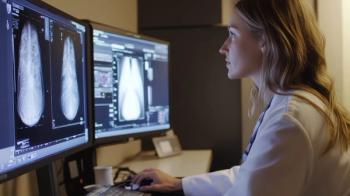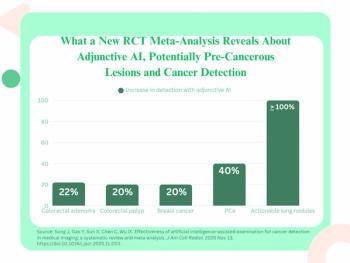
PET/CT prevails over single scans in ovarian cancer
Few diseases pose as many diagnostic challenges as ovarian cancer. Unlike other gynecologic cancers, in which patients can present with tell-tale conditions while the disease is still at an early stage, two-thirds of ovarian cancer cases are advanced when first detected. Identifying postsurgical recurrence is also difficult. According to several studies presented at the 2005 RSNA meeting, PET/CT may have an important role to play in detecting and evaluating this silent killer.
Few diseases pose as many diagnostic challenges as ovarian cancer. Unlike other gynecologic cancers, in which patients can present with tell-tale conditions while the disease is still at an early stage, two-thirds of ovarian cancer cases are advanced when first detected. Identifying postsurgical recurrence is also difficult. According to several studies presented at the 2005 RSNA meeting, PET/CT may have an important role to play in detecting and evaluating this silent killer.
Following initial surgery, most patients present with recurrence of the disease. The basic strategy in treating that recurrence is to perform secondary cytoreductive surgery that can significantly reduce tumor volume. Chemotherapy and irradiation for residual disease follow this regimen. These measures are important to increase median postrecurrence survival time. The absence of a single accurate test makes early detection of ovarian cancer recurrence challenging, even if a clinician's toolbox includes advanced radiological and biochemical techniques.
CT, MRI, and PET are used in addition to CA-125 levels to evaluate ovarian cancer recurrence. However, a considerable amount of postsurgical anatomical distortion exists, making detection problematic. Metastatic deposits from ovarian cancer commonly occur through the peritoneal route, presenting another challenge. These deposits can implant on the bowel, paracolic gutters, and subphrenic regions.
Serial serum CA-125 levels are a relatively accurate way to monitor response to cytoreductive surgery. But even in the presence of recurrence it is possible to have normal CA-125 levels. Imaging thus plays a crucial role not only for surgical planning but also in monitoring response to chemotherapy.
In most centers, contrast-enhanced CT of the abdomen and pelvis is the mainstay to detect ovarian cancer recurrence, according to Dr. Sunit Sebastian, a research associate at Emory University in Atlanta. CT provides excellent anatomic definition but lacks the vital functional information necessary to accurately identify abnormalities. Patients can also have increasing serial CA-125 levels and a nondiagnostic CT scan due to the presence of low volume metastatic deposits. Furthermore, a decrease in the size of residual tumor as demonstrated on CT is often considered a favorable response to treatment. But even a small residual mass can harbor tumor cells and trigger full-blown recurrence of disease. Therefore, it is impossible to conclude that a complete resolution of the disease process has been achieved on the basis of a contrast CT of the abdomen and pelvis alone.
FDG-PET imaging can evaluate the physiologic and biochemical nature of tumors that cannot be obtained with CT or MRI. However, normal physiologic activity in bowel, ovaries, and ureters often results in false positives and negatives when using FDG-PET alone. Poor anatomical depiction is another drawback of the technique.
In a study conducted at Massachusetts General Hospital, Sebastian and Dr. Susanna Lee found that integrated PET/CT imaging performed at the same sitting was more accurate than CT or PET alone for detecting ovarian cancer recurrence in the abdomen and pelvis, and also in the chest. The analysis included 54 consecutive CT, PET, and PET/CT exams performed at MGH on 53 women for tumor recurrence after primary debulking surgery for histologically proven ovarian cancer.
PET/CT demonstrated higher sensitivity, specificity, and accuracy in detecting ovarian cancer recurrence compared with PET and CT alone. For the entire body, the sensitivity for CT, PET, and PET/CT was 92%, 82%, and 97%, respectively. Specificity was 60% for CT, 67% for PET, and 80% for PET/CT. Accuracy was 83%, 77%, and 92% for CT, PET, and PET/CT.
Sebastian noted the presence of metastatic deposits in the chest without obvious disease in the abdomen in a small number of patients. He concluded that it would be prudent to include PET/CT of the chest to detect ovarian cancer recurrence.
"Hybrid PET/CT demonstrates significant advancement in the detection of ovarian cancer recurrence, especially in the setting of rising titers of tumor markers and nondiagnostic CT," Sebastian said. "However, vigilant radiological and biochemical surveillance is the only way to detect early recurrence of ovarian cancer and improve survival."
In another study presented at the meeting, Dr. Sandro Sironi at the University of Milan evaluated 30 consecutive patients with suspected ovarian cancer recurrence with both abdominal contrast-enhanced CT and PET/CT. The dual modalities were not only more sensitive than CT alone (93% vs. 63%), they also changed clinical management in nearly half the patients.
Since the National Oncologic PET Registry became operational in May, interim reimbursement is available for PET imaging to diagnose, stage, restage, or monitor ovarian cancer. Permanent coverage will be granted when enough evidence attests to PET's efficacy in these patients.
Newsletter
Stay at the forefront of radiology with the Diagnostic Imaging newsletter, delivering the latest news, clinical insights, and imaging advancements for today’s radiologists.



























